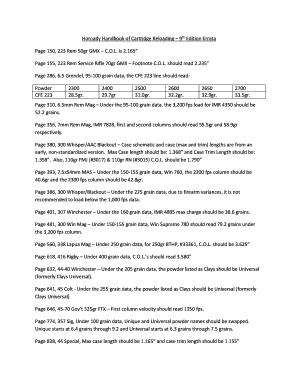Hornady 9th, 1st edition, 300 Blackout section, is a perfect example of a loading manual trying to get a new reloader killed, and why multiple resources are needed. A perfect example of why reading the section that has how to information is more important than the data.
Here are the correction to that manual.
Page 380, 300 Whisper/AAC Blackout – Case schematic and case (max and trim) lengths are from an early, non-standardized version. Max Case length should be: 1.368” and Case Trim Length should be: 1.358”. Also, 110gr FMJ (#3017) & 110gr RN (#3015) C.O.L. should be 1.790”
Page 382, 300 Whisper/AAC Blackout – 150-155gr C.O.L.’s should read: GMX-1.962”, InterBond-2.210”, SST-2.210”, FMJ-BT-2.090”, Interlock RN-1.900”, InterLock SP & BTSP-2.106”, A-MAX-2.110”
Page 393, 7.5x54mm MAS – Under the 150-155 grain data, Win 760, the 2200 fps column should be 40.6gr and the 2300 fps column should be 42.8gr.
Page 386, 300 Whisper/Blackout – Under the 225 grain data, due to firearm variances, it is not recommended to load below the 1,000 fps data.
https://press.hornady.com/assets/pcthum ... 702177.pdf

When changing bullets in given data you need to know the difference in length and profile. How much bullet will be in the case, if the bullet is jamming into the rifling. As an example if you look at the 150 FMJ data in the 9th edition first printing, the case trim length will crimp the bullet in the chamber, and the bullet will be jammed into the rifling at the published length. Note every 150 grain bullet has a corrected length in the Errata.
If you go to JBM Ballistics where you can find lists of bullet lengths you find more than a dozen 150-155 grain Hornady bullets ranging from .905”-1.327”. Across all manufacturers there are probably 100 bullets in that caliber the weight class of 147-155.
To keep yourself safe, even from published data, you need to know bullet seated depth and what length the bullet contact the lands.
Seated depth is easy to compare.
Bullet length + case length - COL= Seated depth. How much bullet in the case.
Take the seated depth of the bullet you have data for
Bullet length + case length - seated depth = COL, of the new bullet you want to use.
If you make up a dummy round, no primer or powder, to COL you want to use and insert it into the chamber with finger pressure, it should drop out. If it sticks, that length is to long and you need to adjust.
Tools like the Hornady comparator, make that easier, but are not completely needed.
If you search the forum you find interesting issues in the early years. Things like high pressure spikes using published data, noveske making “match chambers” that were cut short enough that factory ammo blew primers out.
It up to you to keep yourself safe, a good handle on ammo manufacturing will help a lot.
I need to add that I really like the Hornady manuals, and they are not the only ones to make this type of mistake. Just pointing out the only person who can keep you safe, is you.
